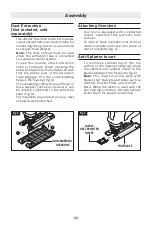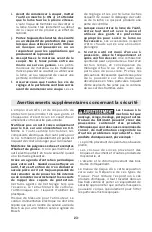
-15-
Plunge cutting
Plunge cutting is useful and time-saving
i n m a k i n g r o u g h o p e n i n g s i n s o f t e r
materials. It is not necessary to drill a
hole for an inside or pocket cut. The
longest blade to be used for plunge
cutting is 3-1/8" (80 mm). Footplate
must be set 0° setting. (Fig. 7).
Draw lines for the opening, hold the
saw firmly, tilt it forward so that the toe
of the saw foot rests on the work, but
with the blade well clear of the work.
Turn the tool on and run at top speed,
and then very gradually lower the blade
(Fig. 8).
When it touches, continue pressing
down on the toe of the saw foot slowly
pivoting the saw like a hinge until the
blade cuts through and the foot rests
flat on the work. Then saw ahead on the
cutting line. We do not recommend
plunge cutting with a scroll blade. Do
not try to plunge cut into hard materials
such as steel.
To make sharp corners, cut up to the
corner, then back up slightly before
rounding the corner. After the opening
is complete, go back to each corner and
cut it from the opposite direction to
square it off.
Operating Instructions
Fig. 8
Fig. 7
















































